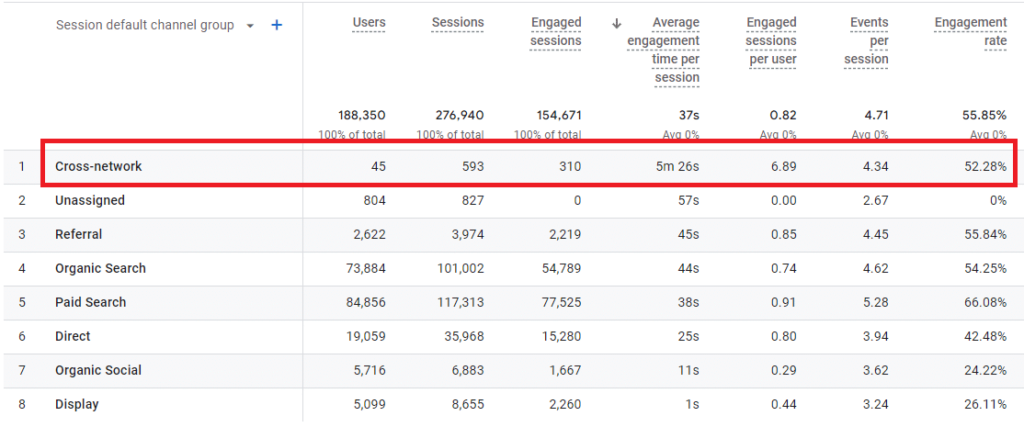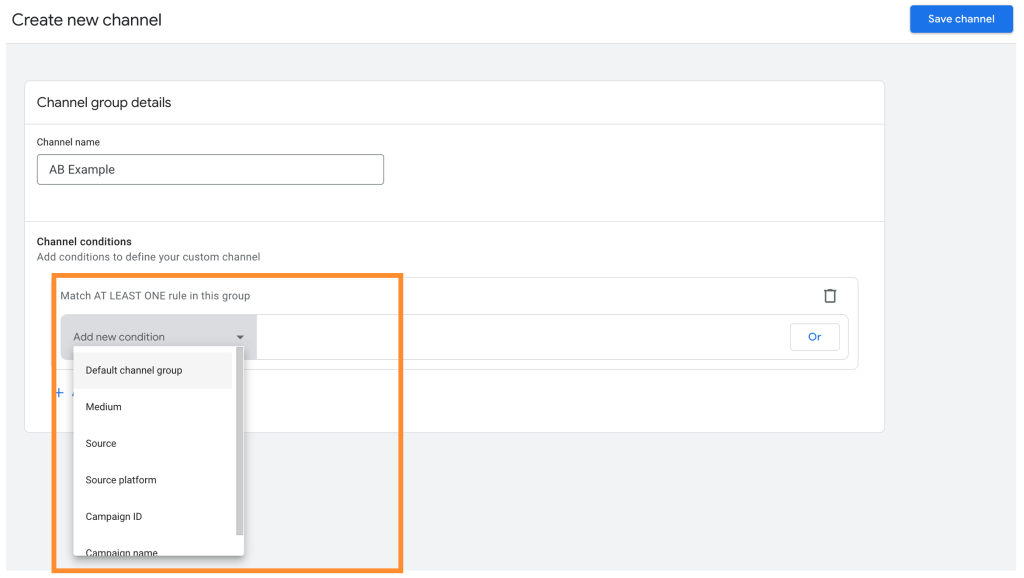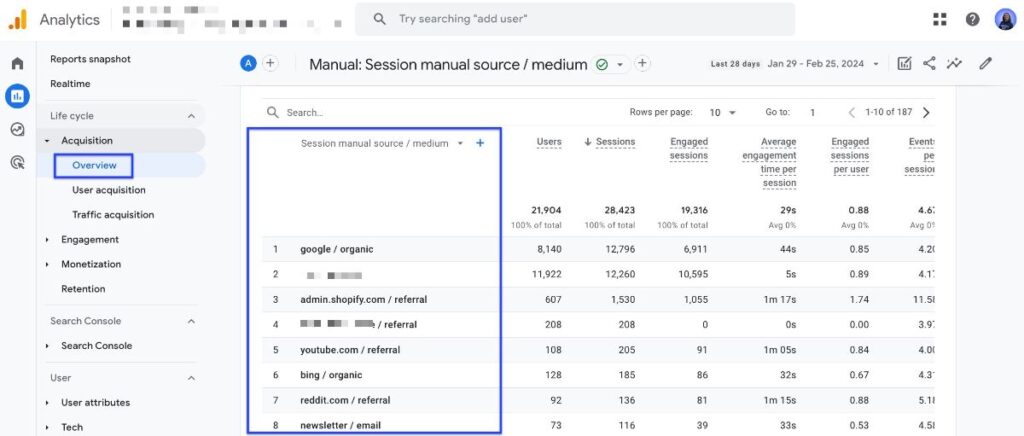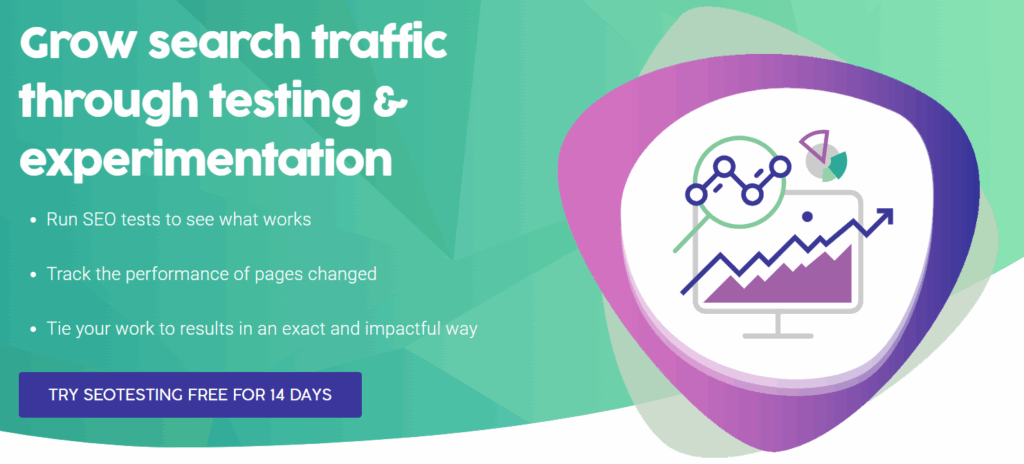The cross-network channel in GA4 groups visits from Google Ads campaigns that are eligible to run across multiple Google properties into a single channel.
This traffic comes from:
- Google Discover Traffic
- Google Performance Max Campaigns
- Google Shopping Campaigns
Cross-network channel grouping uses campaign-type and placement-based rules, rather than a single primary traffic source, to assign sessions to this channel. It includes campaigns that run across several Google platforms at the same time. These platforms include:
- Google Display Network
- Google Discover
- Gmail
- YouTube

Table of Contents
- How GA4 Groups Traffic Into Default Channels
- Cross-Network Data Attribution Problems
- How to Fix Cross-Network Attribution Issues
- Benefits of Cross-Channel Grouping
- Cross-Network vs Other GA4 Default Channels
- Best Practices for Cross-Network Analysis
- Frequently Asked Questions
Tl;Dr
GA4 can group traffic from multi-placement Google Ads campaigns into one cross-network channel. This includes Google Discover, Performance Max, and Shopping campaigns. You get a consolidated view of performance across all Google properties included in those campaigns, such as Discover, Shopping, and YouTube. But you can’t easily see which individual platform (e.g., Discover vs. YouTube) generates the highest conversions or return on ad spend. Fix this by making custom channel groups and using GA4’s source platform feature.
How GA4 Groups Traffic Into Default Channels
GA4 groups traffic into various default channel groupings for attribution analysis.
Paid Shopping Channel
GA4 places traffic into this channel when it comes from Google Ads campaigns identified as ‘shopping’ in the campaign type or channel grouping configuration. Your main example would be products listed in the Google Shopping section of the SERP.
Paid Search Channel
GA4 places traffic into this channel from Google Ads with the following tags:
- Google Search
- Google Partners
This traffic typically comes from paid text ads shown on Google search results pages. In some configurations, it can also include ads served on Google partner sites, including certain placements on YouTube that are attributed as search traffic.
Paid Video Channel
Paid video traffic comes from ads with YouTube Search or YouTube Video tags. The primary example here is traffic coming from YouTube Ads placements, such as in-stream or in-feed video ads.
Display Channel
Display traffic comes from any Google Ads campaign with a Google Display Network tag. By default, traffic from campaigns serving on the Google Display Network is grouped into this channel, unless custom channel rules override it.
Paid Social Channel
GA4 shows paid social ad traffic in this channel. It comes from advertisements with the Social tag enabled. Common examples are ads from external social networks such as Facebook, X (Twitter), and Instagram.
Cross-Network Channel Definition
The Cross-Network channel shows traffic from Google Ads campaigns that are tagged as Cross-Network in GA4’s default channel grouping rules. This could be traffic from:
- Google Discovery
- Performance Max campaigns
- Google Smart Shopping
Side note: If you wish to learn how to find referral traffic in Google Analytics 4 and what it means, check our guide on the blog.
Cross-Network Data Attribution Problems in GA4
Grouping traffic from different networks in one channel creates specific attribution challenges, such as reduced visibility into platform-level performance and budget effectiveness. SEO specialists lose visibility into which specific Google properties (e.g., Discover vs. YouTube vs. Shopping) are driving sessions and conversions.
You Can’t Identify Which Network Drives Performance
When multiple Google properties are grouped together, you can’t tell whether a specific visit came from Discover, YouTube, Shopping, or another placement. You can’t see which network led to a conversion. This makes it hard to see how each ad network is doing in your reports.
When a particular platform starts underperforming, for example, when conversions or ROAS drop, you need to identify it quickly. Without clear data segmentation, you have to guess what went wrong. Guessing can lead to misallocated budgets, pausing effective placements, or continuing to fund underperforming ones.
GA4’s Data-Driven Attribution Model Creates Confusion
GA4 uses a data-driven attribution model that splits credit between touchpoints. The algorithm decides how much credit each step gets. This makes it difficult to quantify the exact share of conversions that should be attributed to each individual platform.
GA4 tries to show the full customer journey picture. But when networks work together in cross-network campaigns, attribution gets messy. You can’t precisely determine how much each network contributes to key metrics such as conversions, revenue, or assisted conversions.
This attribution ambiguity limits your ability to compare campaigns accurately, forecast outcomes, and justify budget increases or cuts. You can’t confidently allocate budgets to each channel based on its true incremental impact.
Limited Network-Level Optimization Data
If you don’t know which network delivers the highest ROI or conversion rate, you can’t prioritize optimizations that raise overall performance. You can’t move budgets to better-performing networks. You can’t change strategies based on granular performance data.
Say you want to increase spend on Performance Max campaigns. But you don’t know which landing pages work best for these campaigns. You can’t determine which specific campaigns, ad groups, or landing pages should receive additional budget.
Campaign-Level Performance Visibility Issues
Enterprise-level marketers often run lots of different campaigns at the same time. GA4 lumps all cross-network results together in one channel. You can’t see each individual campaign’s contribution to conversions, revenue, or assisted conversions.
This makes it difficult to identify which campaigns generate the highest revenue, profit, or lifetime value. You can’t calculate accurate campaign-level ROI or determine individual campaign value.
How to Fix Cross-Network Attribution Issues
Now we know what goes wrong with GA4’s cross-network channel. Here are some solutions to these attribution problems.
Create Custom Channel Groupings in GA4
Custom channel groups let you organize your channels based on your specific reporting needs, such as separating brand vs. non-brand or prospecting vs. remarketing traffic. You can group them based on what matters to your attribution analysis. This helps you identify which channels deliver the strongest performance for goals like leads, online sales, or trial signups.
When you create these custom groupings, you can spot your best performers. You can then give more budget into the channels that bring you the most value.

Use GA4’s Source Platform Dimension
GA4 has a source platform feature that shows you exactly where your traffic comes from. It breaks down results by each individual platform. This lets you compare metrics such as sessions, conversions, and revenue for each individual platform.
You can see which platforms work well in your customer journey. You can also spot the ones that need optimization. This helps you create better-targeted campaigns.

Use Other Analytics Tools
GA4 covers many standard attribution scenarios, but it may not support complex requirements such as multi-touch attribution across offline and online channels. Using other analytics tools helps you see how your marketing is actually doing.
You can use CRM systems to track customers better across touchpoints. Advanced attribution software can model user journeys across multiple channels and devices, showing the relative lift each touchpoint provides. Business intelligence platforms help you dig deeper into your performance data.
These supplementary tools provide additional capabilities, such as cross-channel user-level tracking or offline conversion integration, that GA4 does not natively offer. They give you clearer insights into individual customer journeys and isolate each campaign’s incremental impact on conversions.
Test Different Attribution Models
You are not limited to GA4’s default data-driven attribution model. You can experiment with alternative attribution models to see which one aligns most closely with your sales cycle and decision-making process.
You can try last-click models that give all credit to the final touchpoint. First-click models give credit to the first touchpoint. Linear models spread credit evenly across all touchpoints. Time decay models give more credit to recent touchpoints.
Testing different models helps you find what matches your customer journey best. This leads to better decisions about where to spend your marketing budget.

Benefits of Cross-Channel Grouping
Cross-network grouping in GA4 offers several practical benefits for SEO specialists, including a unified view of paid traffic and easier comparison with organic performance. It can help your marketing analysis in several important ways.
Consolidated Multi-Platform Campaign Overview
Cross-network grouping shows you traffic from multi-platform Google Ads campaigns in one consolidated view. You can see the total impact of your ads across different platforms. This includes Google Discover, Performance Max campaigns, and Google Shopping campaigns.
This consolidated view reduces the number of separate reports you need to review to understand overall Google Ads performance. You don’t have to switch between separate reports for Display, Discover, Shopping, and YouTube to see combined results. You save time and make fewer mistakes when analyzing your performance data.
Simplified Campaign Management Workflows
Running campaigns across multiple Google platforms at the same time can be complex, especially when you’re managing budgets, creative variations, and targeting separately. Cross-network grouping makes it simpler to manage. You can see all your campaigns in one unified view.
You can track ads on Google Display, Discover, Gmail, and YouTube all at the same time. This makes it easier to spot drops in click-through rate, conversion rate, or ROAS and then adjust bids, budgets, or targeting in response.
When you see all platforms together, you can verify that every campaign supports a clearly defined objective, such as lead generation or online sales. This helps your marketing strategy work more effectively.
Cross-Platform Synergy Analysis
Cross-network grouping shows how different Google platforms interact within a user journey, such as Discover driving initial awareness and YouTube contributing to conversion later. You can see how they work together in your customer journey and attribution path.
Some platforms may deliver higher conversion rates or lower acquisition costs when used in combination than when run in isolation. You might miss how platforms work together if you only look at them one by one.
This consolidated view helps you make smarter choices about your budget allocation. You can find the best combinations of platforms. You can allocate more budget to platform combinations that generate the highest incremental conversions or revenue.
Cross-Network vs Other GA4 Default Channels
It’s important to know how cross-network is different from other GA4 channels.
Cross-network groups traffic from many Google ad platforms. Other channels usually show one traffic source or campaign type.
This difference affects how accurately you can attribute conversions and revenue to specific platforms. It also changes how you prioritize optimization efforts, such as which placements to scale or which creatives to test.
Channels like Paid Search or Display show clearer paths. But cross-network needs more digging to see what each platform really adds.
Best Practices for Cross-Network Analysis
Use these tips to get more value from cross-network data in GA4:
Segment Your Analysis
Use GA4 exploration reports to split cross-network traffic by source. This helps you see each platform’s contribution to sessions, engagement, and conversions.
Create Custom Dimensions
Configure custom dimensions (for example, campaign goal, funnel stage, or audience type) to add more context to cross-network tracking and attribution.
Test Attribution Models
Check how cross-network traffic performs with different models. This helps you identify the attribution model that most closely matches your actual sales cycle and decision-making process.
Check Landing Pages
Look at how landing pages work for cross-network visits. Improve the landing pages that have low conversion rates or high bounce rates for cross-network traffic.
Budget Allocation Testing
Test different budget allocations across cross-network campaigns to increase conversions, revenue, or ROAS.
Frequently Asked Questions
What Does Cross-Network Include in GA4?
Cross-network groups traffic from these Google platforms:
- Google Discover ads
- Performance Max campaigns
- Google Shopping campaigns
- Google Display Network ads
- Gmail ads
- YouTube ads
Any Google Ads campaign that runs on multiple platforms gets put in this channel.
Why Does GA4 Group These Networks Together?
GA4 groups these networks because certain campaign types, such as Performance Max, are designed to run across multiple placements within a single campaign. Performance Max campaigns run on Google Search, Display, YouTube, Gmail, and Discover all at once. GA4 treats these placements as one combined channel for attribution, rather than assigning them to separate default channels by property.
How Do I See Individual Platform Performance?
You can break down cross-network traffic in three ways:
Use Source Platform Dimension
Go to GA4’s source platform feature. This shows you exactly which platform brought each visitor.
Make Custom Channel Groups
Create your own channel groups based on what matters to your business. Group platforms by performance or campaign type.
Use Exploration Reports
Run exploration reports in GA4. Segment cross-network traffic by source to see detailed breakdowns.
How Is Cross-Network Different From Other GA4 Channels?
When you use GA4’s data-driven attribution model, conversions attributed to the cross-network channel can be split across multiple platforms that participated in the user journey. Other channels like Paid Search show clear, direct paths. Cross-network shows a more complex journey across platforms.
Regular channels track one traffic source. Cross-network tracks many sources working together.
Should I Stop Using Cross-Network Campaigns?
No. Cross-network campaigns can be effective for generating broad reach and driving incremental online sales when configured and measured correctly. Don’t avoid them. Instead:
- Make custom channel groups
- Use source platform analysis
- Test different tracking models
- Add other tracking tools to GA4
These steps give you more detailed performance data, such as platform-level ROAS and conversion volume, without sacrificing the reach and automation benefits of cross-network campaigns.
Can I Use Cross-Network Data for SEO?
Cross-network focuses on paid ads, not organic search. But you can still extract SEO-related insights, such as which landing pages and content formats perform best with paid visitors:
Landing Page Performance
See which pages work well with cross-network traffic. Use this data to improve your SEO pages.
User Behavior Patterns
Understand how users view, scroll, click, and convert on your content across different Google platforms. Apply these insights to organic content.
Content Ideas
Identify content topics and formats that achieve strong engagement and conversion rates across multiple Google platforms. Create similar content for SEO. For direct SEO tracking, use GA4’s organic search channel instead.
Wrapping Up: Optimizing Cross-Network Performance in GA4
Cross-network grouping in GA4 is highly relevant for today’s SEO specialists and digital marketers because it affects how paid traffic is attributed and reported. It shows you all your Google advertising traffic in one consolidated place. It makes tracking your ads easier across different platforms.
This approach helps you manage multi-platform campaigns more efficiently by centralizing performance data from multiple Google properties. This matters even more when you run ads on Display, Gmail, and YouTube at the same time.
Cross-network grouping shows you how your campaigns work together. This helps you make better decisions about where to spend your marketing budget.
Yes, it has attribution challenges. Data attribution can get confusing when platforms are consolidated. But the solutions we discussed can help you fix these issues.
Custom channel groups give you more granular control. The source platform feature shows you more detailed attribution data. These tools help you work around the consolidation problems.
In the end, cross-network grouping can streamline your marketing analysis by consolidating data, provided you also use custom groupings and source-platform breakdowns to regain detail. It helps you make smarter attribution decisions. It can help you allocate budget to the platforms and campaigns that deliver the highest measurable returns, such as conversions or revenue.
If you manage Google Ads campaigns across properties such as Search, Display, Discover, Gmail, and YouTube, you need to understand what cross-network can and can’t show. Use smart workarounds to track results better and spend your budget more wisely.
Do you want to unlock the full potential of your SEO efforts? Then try SEOTesting.
Sign up for a free 14-day trial and experience our seamless integration with GA4. Track how specific SEO changes affect key GA4 events, such as purchases, lead submissions, or scroll-depth, to base optimizations on measured results rather than assumptions. Use these insights to refine your SEO strategy, for example, by prioritizing pages and queries that show measurable increases in clicks, impressions, and conversions.
Start your free trial today at SEOTesting!


